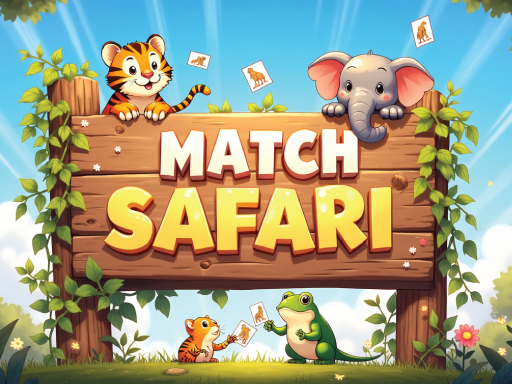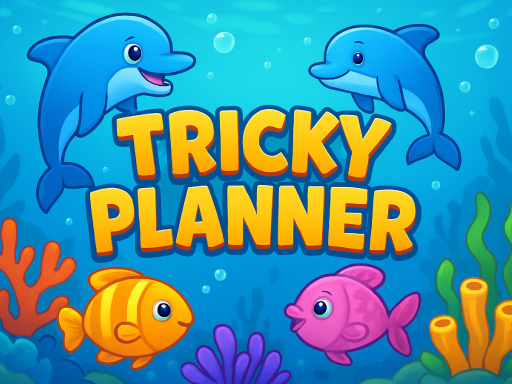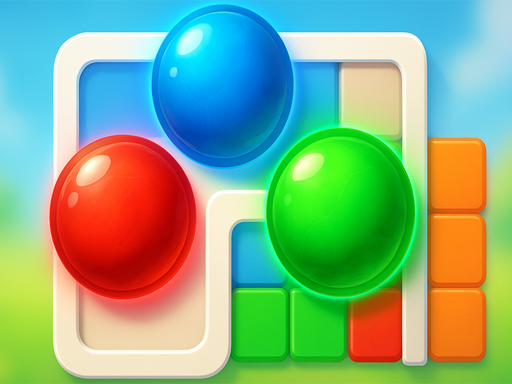Hole Drop Puzzle
About Hole Drop Puzzle
Oh my god, you are not going to believe what I just found. Seriously, drop everything you're doing, because I need to tell you about this game. It's called Hole Drop Puzzle, and I'm not even exaggerating when I say it's completely consumed my brain for the last seventy-two hours. You know how sometimes you stumble across a game, and it just *clicks*? Like, it's exactly the kind of thing you've been craving without even knowing it? That's Hole Drop Puzzle for me. It's this brilliant, unassuming little gem that starts off so deceptively simple, and then, before you know it, you're three hours deep, your coffee's gone cold, and you're practically vibrating with the sheer satisfaction of a perfectly executed solution.
I mean, the core concept, right? It sounds almost too basic: you've got these colored cubes, and your job is to get them into their matching colored holes. That's it. That's the whole pitch. And honestly, when I first saw it, I was like, "Okay, sure, another one of *those*." But oh, my friend, that's where the genius lies. It's the kind of elegant simplicity that masters like Tetris or Sudoku possess. It's not about flashy graphics or an epic storyline; it's about the pure, unadulterated joy of problem-solving, of watching a complex mechanism you've meticulously planned unfold exactly as you envisioned.
What I love about games like this is how they trick you. The first few levels are a breeze, right? They hold your hand, they teach you the basic controls – swipe to move the cubes, release to drop them. You're just gently nudging a red cube into a red hole, a blue into a blue. You're feeling smart, you're feeling confident. "Yeah, I got this," you think. And then, the game, in its infinite, beautiful cruelty, starts to introduce new elements. And that's when your brain really starts to hum.
Suddenly, it's not just about getting a cube from point A to point B. Oh no, that would be far too easy. Now, there are walls. There are blocks that can only be moved in certain directions. There are one-way gates that you can push a cube through, but never pull it back. And the "drop" mechanic, which seemed so straightforward at first, becomes this intricate dance with gravity and spatial awareness. You're not just placing cubes; you're *releasing* them, watching them fall, slide, and bounce. And where they land, and how they interact with other cubes or environmental elements, becomes the entire puzzle.
I remember this one level, early on, that just absolutely stumped me for a good twenty minutes. It had this red cube and a blue cube, and their respective holes were on opposite sides of the board, separated by a maze of immovable blocks. But here's the kicker: to get the red cube into its hole, you *had* to use the blue cube to push it, but then the blue cube would be stuck. And to get the blue cube into *its* hole, you needed the red cube out of the way. It was this beautiful, infuriating paradox. My brain was just short-circuiting, trying to find the sequence, the exact moment to release each cube so that one would clear the path for the other without trapping itself. And when it finally clicked, when I saw that perfect cascade, that satisfying *thunk* as both cubes nestled into their homes, I swear I let out an audible cheer. That's the feeling, you know? That moment of pure, unadulterated intellectual triumph.
The brilliant thing about this is how organically new mechanics are introduced. It's never just "here's a new feature, figure it out." Instead, you'll be faced with a puzzle that seems impossible, and then, almost subconsciously, you'll notice a subtle environmental cue, or a new type of block, and you'll realize, "Ah, *that's* what this is for!" Like the levels where you encounter these pressure plates. You drop a cube onto one, and suddenly a wall retracts, or a platform shifts. But then you need that cube for its own hole, so how do you keep the plate activated? Do you find another cube? Do you use a different path? The game constantly asks these questions, pushing you to think several steps ahead, to visualize the entire sequence of events before you even make your first move.
And then they start throwing in *moving* platforms. Oh my god. Just wait until you encounter those. Now you're not just dealing with static obstacles; you're dealing with timing. You have to anticipate where the platform will be, how fast it's moving, and how that will affect the trajectory of your dropped cube. It's like playing billiards in zero gravity, but with the added pressure of a ticking clock in your head. The tension in your shoulders during those moments, as you line up a shot, knowing that one millimeter off, one millisecond too late, and you've got to reset the whole thing. But then, when you nail it, when the cube lands perfectly on the moving platform, travels across the void, and then drops precisely into its hole, it's just… chef's kiss. It's pure, unadulterated gaming bliss.
The visual style is clean, too, which I really appreciate. It's not cluttered. The colors are vibrant, the cubes are distinct, and the environments are minimalist enough that your focus is always on the puzzle itself. There's a satisfying weight to the cubes as they move, a subtle physics engine at play that makes every drop feel deliberate and impactful. You can almost hear the soft *clink* as a cube nudges against a wall, or the satisfying *whoosh* as it slides down a ramp. It's all designed to enhance that feeling of control and precision, even when the puzzle itself is trying to unravel your brain.
What's fascinating is how the game evolves. You'll find yourself developing these incredible mental models. You start to recognize patterns, to instinctively understand how certain elements interact. It's like learning a new language, where at first you're stumbling over words, but then suddenly you're fluent, anticipating entire sentences. There are levels where you have multiple cubes of different colors, all needing to reach their respective holes, and each move you make with one cube affects the others. It becomes this beautiful, intricate ballet of cause and effect. You're not just solving a puzzle; you're choreographing a solution.
In my experience, the best moments come when you've been stuck on a level for a while, maybe you've walked away, come back, tried a dozen different approaches, and then, out of nowhere, it hits you. That flash of insight, that sudden realization of the *one* move you hadn't considered, the clever interaction you completely overlooked. And then you execute it, and it all just falls into place, a perfect chain reaction of drops and slides and shifts. That's the feeling that keeps me coming back. It's that insatiable curiosity, that drive to untangle the next knot, to conquer the next impossible-looking arrangement of blocks and holes.
There's something magical about games that can achieve such depth and complexity from such a simple premise. It's not about explosions or epic boss battles; it's about the quiet satisfaction of mastering a logical challenge. It's about the feeling of your brain expanding, of seeing the world in a slightly different, more strategic way. And Hole Drop Puzzle does that in spades. It's a game that respects your intelligence, that doesn't spoon-feed you answers, but instead gives you the tools and trusts you to figure it out. And when you do, when you finally crack that seemingly impenetrable puzzle, the reward is so much more profound than any high score or achievement. It's the pure, unadulterated joy of knowing you outsmarted the game.
Honestly, if you're even remotely into puzzle games, if you appreciate elegant design and the thrill of a good mental workout, you absolutely, unequivocally *have* to try Hole Drop Puzzle. It's not just a game; it's an experience. It's that feeling of leaning forward in your chair, your eyes glued to the screen, your mind racing, completely lost in the challenge. It's the kind of game that makes you forget about time, about your responsibilities, about everything else, because for a little while, all that matters is getting that one last blue cube into its hole. And trust me, once you start, you won't want to stop.
I mean, the core concept, right? It sounds almost too basic: you've got these colored cubes, and your job is to get them into their matching colored holes. That's it. That's the whole pitch. And honestly, when I first saw it, I was like, "Okay, sure, another one of *those*." But oh, my friend, that's where the genius lies. It's the kind of elegant simplicity that masters like Tetris or Sudoku possess. It's not about flashy graphics or an epic storyline; it's about the pure, unadulterated joy of problem-solving, of watching a complex mechanism you've meticulously planned unfold exactly as you envisioned.
What I love about games like this is how they trick you. The first few levels are a breeze, right? They hold your hand, they teach you the basic controls – swipe to move the cubes, release to drop them. You're just gently nudging a red cube into a red hole, a blue into a blue. You're feeling smart, you're feeling confident. "Yeah, I got this," you think. And then, the game, in its infinite, beautiful cruelty, starts to introduce new elements. And that's when your brain really starts to hum.
Suddenly, it's not just about getting a cube from point A to point B. Oh no, that would be far too easy. Now, there are walls. There are blocks that can only be moved in certain directions. There are one-way gates that you can push a cube through, but never pull it back. And the "drop" mechanic, which seemed so straightforward at first, becomes this intricate dance with gravity and spatial awareness. You're not just placing cubes; you're *releasing* them, watching them fall, slide, and bounce. And where they land, and how they interact with other cubes or environmental elements, becomes the entire puzzle.
I remember this one level, early on, that just absolutely stumped me for a good twenty minutes. It had this red cube and a blue cube, and their respective holes were on opposite sides of the board, separated by a maze of immovable blocks. But here's the kicker: to get the red cube into its hole, you *had* to use the blue cube to push it, but then the blue cube would be stuck. And to get the blue cube into *its* hole, you needed the red cube out of the way. It was this beautiful, infuriating paradox. My brain was just short-circuiting, trying to find the sequence, the exact moment to release each cube so that one would clear the path for the other without trapping itself. And when it finally clicked, when I saw that perfect cascade, that satisfying *thunk* as both cubes nestled into their homes, I swear I let out an audible cheer. That's the feeling, you know? That moment of pure, unadulterated intellectual triumph.
The brilliant thing about this is how organically new mechanics are introduced. It's never just "here's a new feature, figure it out." Instead, you'll be faced with a puzzle that seems impossible, and then, almost subconsciously, you'll notice a subtle environmental cue, or a new type of block, and you'll realize, "Ah, *that's* what this is for!" Like the levels where you encounter these pressure plates. You drop a cube onto one, and suddenly a wall retracts, or a platform shifts. But then you need that cube for its own hole, so how do you keep the plate activated? Do you find another cube? Do you use a different path? The game constantly asks these questions, pushing you to think several steps ahead, to visualize the entire sequence of events before you even make your first move.
And then they start throwing in *moving* platforms. Oh my god. Just wait until you encounter those. Now you're not just dealing with static obstacles; you're dealing with timing. You have to anticipate where the platform will be, how fast it's moving, and how that will affect the trajectory of your dropped cube. It's like playing billiards in zero gravity, but with the added pressure of a ticking clock in your head. The tension in your shoulders during those moments, as you line up a shot, knowing that one millimeter off, one millisecond too late, and you've got to reset the whole thing. But then, when you nail it, when the cube lands perfectly on the moving platform, travels across the void, and then drops precisely into its hole, it's just… chef's kiss. It's pure, unadulterated gaming bliss.
The visual style is clean, too, which I really appreciate. It's not cluttered. The colors are vibrant, the cubes are distinct, and the environments are minimalist enough that your focus is always on the puzzle itself. There's a satisfying weight to the cubes as they move, a subtle physics engine at play that makes every drop feel deliberate and impactful. You can almost hear the soft *clink* as a cube nudges against a wall, or the satisfying *whoosh* as it slides down a ramp. It's all designed to enhance that feeling of control and precision, even when the puzzle itself is trying to unravel your brain.
What's fascinating is how the game evolves. You'll find yourself developing these incredible mental models. You start to recognize patterns, to instinctively understand how certain elements interact. It's like learning a new language, where at first you're stumbling over words, but then suddenly you're fluent, anticipating entire sentences. There are levels where you have multiple cubes of different colors, all needing to reach their respective holes, and each move you make with one cube affects the others. It becomes this beautiful, intricate ballet of cause and effect. You're not just solving a puzzle; you're choreographing a solution.
In my experience, the best moments come when you've been stuck on a level for a while, maybe you've walked away, come back, tried a dozen different approaches, and then, out of nowhere, it hits you. That flash of insight, that sudden realization of the *one* move you hadn't considered, the clever interaction you completely overlooked. And then you execute it, and it all just falls into place, a perfect chain reaction of drops and slides and shifts. That's the feeling that keeps me coming back. It's that insatiable curiosity, that drive to untangle the next knot, to conquer the next impossible-looking arrangement of blocks and holes.
There's something magical about games that can achieve such depth and complexity from such a simple premise. It's not about explosions or epic boss battles; it's about the quiet satisfaction of mastering a logical challenge. It's about the feeling of your brain expanding, of seeing the world in a slightly different, more strategic way. And Hole Drop Puzzle does that in spades. It's a game that respects your intelligence, that doesn't spoon-feed you answers, but instead gives you the tools and trusts you to figure it out. And when you do, when you finally crack that seemingly impenetrable puzzle, the reward is so much more profound than any high score or achievement. It's the pure, unadulterated joy of knowing you outsmarted the game.
Honestly, if you're even remotely into puzzle games, if you appreciate elegant design and the thrill of a good mental workout, you absolutely, unequivocally *have* to try Hole Drop Puzzle. It's not just a game; it's an experience. It's that feeling of leaning forward in your chair, your eyes glued to the screen, your mind racing, completely lost in the challenge. It's the kind of game that makes you forget about time, about your responsibilities, about everything else, because for a little while, all that matters is getting that one last blue cube into its hole. And trust me, once you start, you won't want to stop.
Enjoy playing Hole Drop Puzzle online for free on Petlg Games. This Puzzle game offers amazing gameplay and stunning graphics. No downloads required, play directly in your browser!
How to Play
Do you have the skills to solve every puzzle With increasing difficulty and new challenges at every level Cube to Hole Puzzle will keep you entertained for hours





Comments
This game is awesome! I love the graphics and gameplay.
One of the best games I've played recently. Highly recommended!